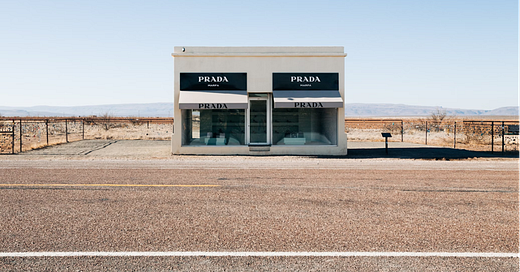Prada’s Fall/Winter show was not just a runway event—it was a cultural moment. Entitled Raw Glamour, Prada’s appearance in last week’s Milan fashion show displayed a collection that redefined femininity, beauty standards and effortless cool while pushing the boundaries of what we deem attractive, desirable, or even acceptable.

In a time when beauty standards are constantly shifting and everyone seems to be getting their filler dissolved, Prada presented a radical rejection of “ladylike” fashion and maintenance. Through aggressive, unflattering silhouettes, undone hems, scrunched-up pyjama separates, dark, harsh brows and messy-bed hair, this collection created a direct response to continuous debates about identity, liberation, and aesthetic contradictions. If you are familiar with Miuccia Prada and Raf Simons’ work through the years, you will know that they have an unmatched ability to take the temperature of the world and translate it into a fashion experience. They don’t ask for approval—instead, they take the lead and subvert it in a way that may confuse the masses.
For decades, Prada has historically shaped the discourse in fashion, being at the forefront of fashion’s intellectual evolution. Miuccia Prada, no stranger to politics, obtained her PhD in Political Science in 1978 at the University of Milan. I guess one could say that this fashion week in Milan was a full circle moment. Drawing from her political background, she recognises fashion as more than just pretty clothes on a runway. For Miuccia, fashion was never merely about glitz and glamour—it served as a language to communicate ideologies, shifts, and important moments of the time. Prada’s approach has always been about challenging the status quo, taking current cultural and societal issues and translating them into something that is both conceptual and visually engaging. The Prada Show at Milan Fashion Week 2025 was no different and served as a significant moment in fashion history.
The collection encompassed the primary goal of liberating women from the rigid female stereotypes present in society. It was constructed of a variety of silhouettes, materials, and styling choices that strayed away from the conventional assumptions of what a fashion show is supposed to be. In place of tight, body-con little-black-dresses, Prada sent oversized knit dresses down the runway. Lingerie and silk robes were swapped for crumpled pyjamas and reimagined as daywear. Bold necklaces weren’t added as accessories but embedded into ribbed, jewelled necklines repurposed from prim cardigans. Clean, tailored hems gave way to raw, exposed seams deliberately left unfinished, challenging traditional notions of polish and perfection. Waistlines were skewed by scrunched-up men’s shirts, and closet staples were dressed up with faux fur accents on coats and blazers.
The initial impression of Prada's collection was one of discomfort—even disdain. The New York Times reported that it was “aggressive and thrillingly unflattering.” The fashion industry is dominated by influencers, models, and celebrities who embody a carefully curated “effortless” aesthetic that envisions being raw, undone and unfiltered. Yet, when it is presented on the runway, stripped of its social context and without the implicit approval of trendsetters, it somehow doesn’t land. Thus, the collection forces confrontation. Prada lays down the red carpet for a larger conversation about effortlessness, chicness, and realness. Why do we accept messy hair, no makeup, and undone, unfiltered styling choices on the “cool girl” but disapprove when it appears on the runway?
Prada tackled this question fiercely, forcing the audience to confront that hypocrisy, decontextualising effortlessness, and reshaping (or rather de-shaping) glamour itself. Hence the title: Raw Glamour. The impact of this collection on the fashion industry challenged and redefined trends, opposing the “cool-girl” aesthetic and the unreachable “clean-girl” aesthetic. It was a deliberate rejection of polished femininity and the societal expectation that women must always appear impeccably maintained.
This collection challenges our ideas of what it truly means to be beautiful and who gets to embody those ideals, which is exactly what Prada stands for. Prada’s world is a matriarchy, run by busy, multi-faceted and complex women who may not have time to brush their hair every day or pull the thread from their hem before leaving the house. As the New York Times puts it, Prada’s vision wasn’t about pleasing anyone “except the body inside the clothes.” So, whether loved or loathed, the Raw Glamour 2025 collection has sparked an important conversation on politics in fashion, beauty, and cultural identity—one that will continue long after the last model has left the runway.



